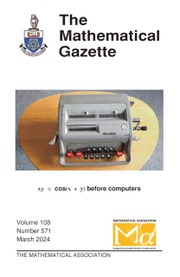No CrossRef data available.
Article contents
Odd run sums and fractions
Published online by Cambridge University Press: 20 June 2025
Extract
A series of consecutive odd numbers has interesting properties useful for classroom investigation [1]. This Article was inspired by the series of fractions for  ${{1}\over{2}}$ using only sums of consecutive odd numbers
${{1}\over{2}}$ using only sums of consecutive odd numbers $$\frac{1}{3} = \frac{{1 + 3}}{{5 + 7}} = \frac{{1 + 3 + 5}}{{7 + 9 + 11}} = {\text{ }} \ldots {\text{ }} = \frac{{1 + 3 + {\text{ }} \ldots {\text{ }} + (2n - 3) + (2n - 1)}}{{(2n + 1) + (2n + 3) + {\text{ }} \ldots {\text{ }} + (2n + (2n - 1))}}.$$
$$\frac{1}{3} = \frac{{1 + 3}}{{5 + 7}} = \frac{{1 + 3 + 5}}{{7 + 9 + 11}} = {\text{ }} \ldots {\text{ }} = \frac{{1 + 3 + {\text{ }} \ldots {\text{ }} + (2n - 3) + (2n - 1)}}{{(2n + 1) + (2n + 3) + {\text{ }} \ldots {\text{ }} + (2n + (2n - 1))}}.$$
Information
- Type
- Articles
- Information
- Copyright
- © The Authors, 2025 Published by Cambridge University Press on behalf of The Mathematical Association
Footnotes
*
Visiting Teaching Fellow, Mathematics Department, University of Surrey
References
Sangwin, C., Sums of the first n odd integers, Math. Gaz. 107 (March 2023)pp. 10–24.CrossRefGoogle Scholar
Dickson, L. E., History of the theory of numbers: Vol 1 Divisibility and primality Dover (2005), ch XIV, p. 357.Google Scholar
Knott, R., Odd runs and their sums, accessed November 2024 at https://r-knott.surrey.ac.uk/runsums/oddrunsums.html
Google Scholar


